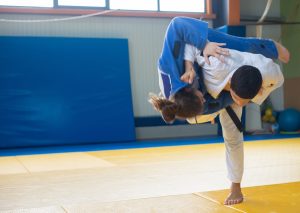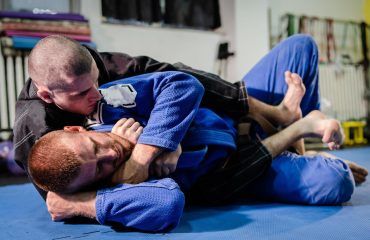
In the world of martial arts, two disciplines, judo and bjj, often spark intrigue and debate among enthusiasts and practitioners. These excellent martial arts, while sharing some similarities, possess distinct characteristics that set them apart.
In this exploration, we dive into the essence of “Judo vs. BJJ,” unraveling the unique aspects of each discipline, and how they compare and contrast in their techniques, philosophies, and applications in self-defense and competitive sports. This distinction is particularly important for bjj fighters, who often incorporate elements of both arts to refine their skills for jiu-jitsu tournaments or mixed martial arts (MMA).
Judo, known for its dynamic standing techniques and effective throws, contrasts with BJJ or Brazilian Jiu-Jitsu, which emphasizes ground fighting and submission holds. In the context of BJJ vs Judo for self-defense, Judo’s throws and takedowns are compared with BJJ’s ground fighting and submissions to determine which may be more effective depending on the scenario. We also compare their belt ranks, discuss the health benefits of each, and explore why BJJ is often called the “gentle art.”
This analysis highlights the key differences and showcases real-world applications in events such as jiu-jitsu tournaments, providing a comprehensive understanding of judo and BJJ. Insights come from us at Noco Jiu-Jitsu and Self-Defense, a renowned academy known for our expertise in these fighting styles.
Judo: The Gentle Way

Judo, meaning “the gentle way” in Japanese, is a martial art that emphasizes throws, takedowns, and immobilization techniques. Developed in 1882 by Jigoro Kano, kodokan judo was derived from the older martial art of Jujutsu. Kano’s vision was to create a system that not only involved physical training but also personal development, instilling values like respect, discipline, and perseverance. This philosophy extends beyond the dojo, as judokas are encouraged to apply these principles in their daily lives, fostering a sense of responsibility and ethical behavior.

In judo, practitioners, known as judokas, wear a gi (uniform) and engage in a form of combat that focuses on using an opponent’s force against them. The art is renowned for its spectacular throwing techniques such as the Seoi Nage (shoulder throw) and Osoto Gari (large outer reap).
Among these, judo throws like the Seoi Nage and Osoto Gari demonstrate the art’s dynamic approach to combat. Grip fighting is crucial as it helps judokas gain a more dominant position to execute hip throws effectively. Groundwork in judo emphasizes pinning techniques, alongside joint locks and strangles, but these are secondary to the art’s primary focus on throws. Judo’s effectiveness in self-defense situations lies in its ability to neutralize an opponent swiftly and efficiently, making it an ideal martial art for those looking to learn practical defense skills. When considering judo or jiu-jitsu for self-defense, it’s important to note that judo’s dynamic throwing techniques are particularly effective in street altercations.

An essential aspect of judo training is “randori,” or free sparring, where judokas practice techniques in a dynamic, unrehearsed setting. This allows practitioners to develop their reflexes, improve their decision-making under pressure, and understand the application of judo techniques in realistic scenarios. The competitive aspect of judo, introduced by Kano, has also played a crucial role in its global spread.
Judo competitions recognized by the Olympic Committee, test skill, strategy, and mental toughness, offering a platform for judokas to showcase their mastery of the art. The sportive element of judo, governed by a point system, a set of rules, and etiquette, where techniques must be executed from a standing position to score the most points, further reinforces the values of fairness, respect, and honor among competitors.
Moreover, judo’s impact extends beyond the domain of martial arts and into broader social development. Programs around the world have incorporated judo as a tool for youth empowerment, community building, and even rehabilitation. The discipline and physical fitness acquired through judo practice have been shown to benefit individuals in various aspects of life, from improving concentration and work ethic to fostering teamwork and leadership skills.
Judo, therefore, stands not just as a system of combat, but as a holistic approach to personal and community development, resonating with Kano’s original vision of a martial art that serves a greater purpose. Many practitioners find that their personal preferences in martial arts align closely with judo’s philosophy, contributing to its reputation as a highly respected fighting style alongside karate and BJJ.
Brazilian Jiu-Jitsu: The Art of Flexibility

Jiu-Jitsu, or Brazilian Jiu-Jitsu (BJJ), is a martial art that has its roots in the traditional Japanese Jujutsu and Judo. It was developed and modified by the Gracie family in Brazil in the early 20th century. Unlike judo, BJJ places a greater emphasis on groundwork and grappling techniques, such as joint locks and chokeholds, distinguishes it from Judo, where standing throws are dominant. This focus on groundwork makes it highly effective for BJJ fighters competing in jiu-jitsu tournaments or training to excel in muay thai.

BJJ’s strategic approach to combat is one of its defining characteristics. The sport’s tactical nature often resembles a physical chess match, where each move and countermove plays a critical role in the outcome. This aspect makes it particularly appealing to those who enjoy a mental challenge along with physical exertion. The technical depth of BJJ allows for a wide variety of techniques and strategies, making it an endlessly fascinating study for practitioners, known as jiu-jiteiros or bjj practitioners.

This martial art is often referred to as “the art of flexibility” due to its adaptive nature. BJJ practitioners learn to control an opponent by applying techniques that force them into submission, making size and strength less relevant. This principle of leverage is a cornerstone of BJJ, enabling smaller BJJ practitioner to overcome larger opponents effectively. As practitioners progress, moving from white to blue belt and black belt, signifies a deepening understanding of these foundational principles. This leveling of the playing field has contributed significantly to the art’s popularity, particularly among those who might feel physically overmatched in other martial arts.
BJJ’s philosophy revolves around the concept that a smaller, weaker person can successfully defend against a bigger, stronger assailant through leverage and proper technique. Training sessions, or “rolls,” are characterized by a constant give-and-take and constant movement, as practitioners work to gain advantageous positions and apply submissions, while also defending against their training partner’s attempts to do the same. This reciprocal nature of training cultivates not only physical toughness but also resilience, adaptability, and problem-solving skills. Self-defense BJJ is particularly effective in ground fighting scenarios, emphasizing grappling and submission holds to control larger opponents.
Moreover, the community aspect of BJJ cannot be overstated. The culture within BJJ gyms often fosters a deep sense of camaraderie and mutual respect among practitioners. This environment is conducive to learning, as more experienced practitioners typically take an active role in helping beginners grow. It’s common to see a diverse mix of people on the mats, from young children to older adults, all sharing the same passion for learning and improving.
Brazilian Jiu-Jitsu offers a rich and diverse martial arts experience. Its emphasis on ground techniques, strategic approach to combat, and the principle of leverage make it unique and accessible. The art’s focus on skill over brute strength, coupled with its vibrant community, makes it an appealing choice for many seeking both physical and mental growth through martial arts. Indeed, BJJ, alongside Judo, stands as an excellent martial art for those seeking physical and mental growth.
Comparing Judo and Jiu-Jitsu

When comparing “judo vs jiu-jitsu,” it’s important to understand the different approaches each discipline takes. Judo, with its roots in traditional Japanese martial arts, has a strong emphasis on respect, etiquette, and the spiritual aspects of martial arts. Its focus on throws makes it dynamic and fast-paced, suitable for those who enjoy standing combat and quick engagements.
The practice of judo is not just about physical prowess; it’s a discipline that fosters mental fortitude and strategic thinking. Judokas are trained to exploit the slightest imbalance in their opponent’s posture, using timing and leverage rather than brute force. This aspect of judo teaches practitioners not only physical techniques but also the importance of awareness and adaptability in both martial arts and life.

On the other hand, Jiu-Jitsu’s strategy is more about patience, control, and endurance. Its emphasis on groundwork makes it ideal for self-defense scenarios where one might be taken to the ground. BJJ practitioners often find themselves in prolonged engagements, seeking to outmaneuver and submit their opponents. This is where defense BJJ shines, as it allows practitioners to control situations even against larger attackers by utilizing submission holds.
This methodical approach to combat, focusing on grappling and position control, provides a deep understanding of body mechanics and leverage. It’s an art that requires not just physical strength but also a calm and composed mind, able to think several moves ahead of the adversary. Jiu-Jitsu teaches its practitioners the value of resilience and the ability to adapt to changing situations, skills that are invaluable in both self-defense and everyday life.
Each of these grappling arts, in their unique way, imparts lessons that go beyond the mat. Whether it’s the swift precision of judo or the calculated techniques of Jiu-Jitsu, both disciplines offer more than just self-defense skills; they offer a route to personal growth and understanding. As students of Noco Jiu-Jitsu and Self-Defense would attest, training in these arts is not just about learning to fight; it’s about learning to live with discipline, respect, and a deeper understanding of oneself and others.
Applications in Self-Defense and Competitive Sports

Both Judo and Jiu-Jitsu are effective for self-defense. Judo’s throwing techniques are valuable for quickly neutralizing an opponent, while Jiu-Jitsu’s ground control and submission techniques are practical in close-quarters defense scenarios. The ability to adapt to different situations is crucial in self-defense, and both arts offer unique approaches.
Judo’s swift and powerful throws can be decisive in a confrontation, allowing one to take control of a situation by redirecting an attacker’s momentum. This aspect is especially useful in scenarios where maintaining distance and quickly subduing an opponent is necessary.
In contrast, Jiu-Jitsu’s focus on ground fighting offers a strategic advantage in situations where one might be overpowered or taken to the ground. The techniques taught in Jiu-Jitsu, such as joint locks and chokeholds, enable a smaller defender to control and, if necessary, incapacitate a larger aggressor.
In competitive sports, both martial arts have made significant marks. Judo, recognized as an Olympic sport since 1964, focuses on throws and quick wins. Its competitive format rewards agility, strategy, and the ability to execute throws with precision and power. This has made judo a popular sport globally, attracting athletes who enjoy the dynamic and fast-paced nature of the matches.
On the other hand, Jiu-Jitsu, popularized through events like the ADCC (Abu Dhabi Combat Club) and the IBJJF (International Brazilian Jiu-Jitsu Federation) World Championships, showcases the tactical and endurance aspects of martial arts competitions. In BJJ tournaments, matches often involve a chess-like battle of positions and submissions, requiring not just physical strength but also mental acuity and patience.
The sport’s growing popularity is evident in its widespread community and the increasing number of BJJ tournaments held around the world. This competitive aspect of Jiu-Jitsu has also led to its inclusion in various mixed martial arts (MMA) organizations, where its effectiveness in ground fighting is widely recognized.
The integration of Judo and Jiu-Jitsu in self-defense and competitive sports demonstrates their versatility and effectiveness. While each art maintains its unique approach and techniques, both contribute significantly to the field of martial arts, offering practitioners diverse ways to develop their skills, both for personal defense and in the sporting arena. As these arts continue to evolve and gain popularity, they will undoubtedly continue to influence and shape the landscape of martial arts and combat sports worldwide.
Noco Jiu-Jitsu and Self-Defense: A Unique Approach

At Noco Jiu-Jitsu and Self-Defense, we distinctly recognize the unique values and techniques of both Judo and Brazilian Jiu-Jitsu. Our academy proudly offers specialized classes in each discipline, demonstrating the effectiveness and distinctiveness of these martial arts.
We provide separate training programs for Judo, focusing on its dynamic throws and standing techniques, and for Brazilian Jiu-Jitsu, concentrating on its detailed ground fighting and submission strategies. This specialized approach allows students to immerse themselves fully in the individual philosophies and techniques of each art.
By offering distinct classes for Judo and Brazilian Jiu-Jitsu, we ensure that our students gain a deep understanding and proficiency in each discipline, while also appreciating how these arts can complement each other in a comprehensive self-defense framework.
In conclusion, while “judo vs jiu-jitsu” presents a comparison of two distinct martial arts, it’s clear that both have their unique strengths and applications. Whether one prefers the swift and strategic throws of Judo or the patient, methodical groundwork of Jiu-Jitsu, each art offers a rich and rewarding adventure into the world of martial arts.
Through academies like us at Noco Jiu Jitsu and Self Defense, practitioners can experience the best of both worlds, gaining skills that are not only effective in combat but also profound in personal development. Call now!
FAQ: Brazilian Jiu-Jitsu vs. Judo – Unraveling Martial Arts Distinctions
2. Which martial art is better for self-defense, Judo or BJJ?
Both Judo and BJJ are highly effective for self-defense. When considering judo or jiu jitsu for self defense, it's important to note that Judo's dynamic throwing techniques are valuable for quickly neutralizing an opponent in street altercations, while Brazilian Jiu Jitsu excels in positional control and advanced submission maneuvers, making it practical in close-quarters defense. BJJ's principle that a smaller, weaker person can defend against a larger opponent through leverage makes it particularly useful for self-defense.
3. How do Judo and BJJ differ in their competitive aspects?
Judo competitions, recognized by the Olympic Committee, focus on throwing techniques and quick victories through a point system. BJJ matches, popularized through events like the IBJJF and ADCC, involve grappling arts, positional control, and submissions, often requiring endurance and strategy.
4. What are the key differences in training for Judo and BJJ?
Training in Judo, or practicing Judo, involves dynamic standing techniques, throws, and randori (free sparring). It also includes pinning techniques, albeit with less emphasis compared to throws. BJJ training, on the other hand, involves extensive groundwork, positional control, and practicing submissions like arm bars, leg locks, and ankle locks. Both require significant physical training and discipline.
5. Can Judo and BJJ complement each other in martial arts training?
Yes, combining Judo and BJJ can create a well-rounded martial artist. Judo's powerful throws can enhance BJJ's ground techniques, while BJJ's submission skills can benefit a judoka. This combination is useful in various aspects of martial arts, including self-defense and mixed martial arts (MMA).
6. What is the historical background of Judo and Brazilian Jiu-Jitsu?
Judo was developed in 1882 by Jigoro Kano as a form of Japanese Jiu-Jitsu, known as Kodokan Judo. It emphasizes throws and personal development. Brazilian Jiu-Jitsu was later developed by the Gracie family in Brazil, modifying traditional Japanese Jiu-Jitsu and Judo to emphasize ground fighting and submissions, giving rise to Gracie Jiu-Jitsu.
7. How do Judo and BJJ rank practitioners, and what does a black belt signify in each?
Both Judo and BJJ use a belt ranking system to signify a practitioner's level of skill and knowledge. In Judo, achieving a black belt indicates proficiency in throwing techniques and groundwork. In BJJ, a black belt signifies mastery in grappling, submissions, and the ability to control and submit opponents, often taking many years of dedicated practice to achieve.
8. What are the health benefits of practicing Judo or BJJ?
Practicing Judo and BJJ provides numerous health benefits, including improved cardiovascular fitness, increased strength and flexibility, and better mental discipline. These martial arts also foster personal growth, resilience, and problem-solving skills, contributing to overall well-being.
9. What are the applications of Judo and BJJ in self-defense situations?
In self-defense situations, Judo's throwing techniques can quickly subdue an opponent, making it effective in street fights. BJJ's focus on ground control and submissions is valuable for defending against larger attackers in close-quarters scenarios. Both arts teach techniques that can prevent serious injury and enhance self-defense capabilities.
10. How do personal preferences influence the choice between Judo and BJJ?
Personal preferences in martial arts can greatly influence the choice between Judo and BJJ. Those who prefer dynamic, standing combat and quick engagements may gravitate towards Judo. In contrast, individuals who enjoy ground fighting, tactical combat, and the strategic depth of submissions may prefer BJJ. Both arts offer unique benefits and can complement each other, providing a comprehensive martial arts experience.




